Introduction
Feng Shui is an ancient Chinese philosophical system rooted in Taoism. It follows the idea that harmonizing energy in your surrounding environment will result in an improved emotional and physical wellbeing. In order to foster good energy, it is important to know how to design a Feng Shui floorplan.
A basic principle of designing religiously correct Feng Shui floorplans is the bagua map. The bagua map helps you identify which areas of a house or room are associated with certain energies and concepts such as health, finances and family life. For example, the northeast portion of a floorplan may be dedicated to financial opportunities. Knowing where each area should be placed allows for maximum spiritual unity and balance between areas of life.
Incorporating traditional elements into your Feng Shui style can also increase harmony within the home. Colors play an important role in feng shui design, as do shapes, fabrics and textures of furniture pieces used throughout the home. Warm colors can evoke feelings of happiness while cool tones can create a calming atmosphere. Additionally use plants, water features or statues around certain points in order to create more focus on specific topics such as wealth, family dynamics or spirituality. All these elements help create balance within each part of your home, restoring harmony among all aspects of everyday living.
Finally, using “intentional” objects throughout your space like crystals or positive affirmations can strengthen good energy within the room with their positive vibrations combined with your desired goals in mind. As placing objects based on Feng Shui principles has been linked to improved physical and mental health by clearing stagnant energy from spaces – all contributing towards creating a desirable flow overall – following these exact guidelines will ensure your finished project not only looks amazing but positively affects those living in it too!
Getting Started
When beginning the process of designing a feng shui floorplan, it is important to first create an environment of relaxation and introspection. This will help you move through the design process with clarity and focus. Begin by spending some time grounding yourself and centering your body and mind on the task at hand. Take deep breaths and let go of any distractions.
Next, set aside a dedicated space where you can work on the design undisturbed. Gather all the materials that you will need such as pencils, pens, paper, color markers, rulers, tape measurers, and so on. You may also want to bring in items like crystals or other healing stones to represent energy centers throughout your home.
Now that you are prepared physically and mentally, it is time to begin sketching out your floor plan. Start by drawing out every room of your house or apartment including windows, doors, hallways, stairways and bathrooms. After you have mapped out the physical structure of your living space onto paper or digitally using a computer program, start refining details such as measurements of objects within each room like furniture pieces or cabinets. This process provides insight into how the physical structures reflect energy flow within your home.
Once this part is completed start looking more closely at lifestyle needs for each zone in order to determine how to best maximize its potential for healthful energy flow through meaningful placement of furniture and décor objects in addition to colors associated with specific rooms from a feng shui perspective . When considering where items should be placed think about alternative options relative to them being placed near heat sources such as radiators or fireplaces that could interfere with its impact energetically , while also taking into account its purpose aesthetically speaking in order to not detract from overall design elements within each room . Depending on individual circumstance further consultation is sometimes needed with experts if wanting to add specific remedies , symbols , elements etc meant to foster positive energy flows throughout entire home during feng shui interior design process.
Analyzing the Space
Designing a space with feng shui principles is an art form that can move the occupants of a space along their path to greater peace, fortune, and personal growth. To begin with, assess your space to understand its potential for energy flow. Analyzing this energy, also known as Geomancy, is essential in order to create a harmonious environment that harnesses the positive energies and restricts negative ones.
When examining your space through Geomancy you will want to consider the surrounding environment elements such as sunlight and the general slope of the land where the building sits, as well as local water patterns and activity near by, like tidal changes or flooding. Pay attention to important points in your home, such as doorways, windows, hearths and other sources of convergence.You should also consider the total size of the area being evaluated; look at measurements such as height from floor to ceiling or length from wall-to-wall. Additionally focus on aspects like colors used in each room ” deep reds and oranges increase energy flow while blues and greens generally help promote serenity. Lastly take into account any obstructions that could be present inside or outside of your home’s walls (e.g., tall buildings blocking sunlight). By understanding all of these variables you will be better prepared to create an ideal environment that channels positive energies in while redirecting negative forces away – achieving greater harmony between you and your space!
Selecting the Design Elements
When designing a floor plan with feng shui in mind, one important element to consider are the colors and textures of the space. Colors can have a powerful effect on how people feel, so it is important to select colors that will work with the energy of a space. Softer colors such as pastels and neutrals can promote relaxation while more vibrant colors like reds and oranges can bring warmth and cheer. Additionally, light and airy textiles like cottons or linens can add a calming touch while richer textures like velvet or silk provide luxuriousness. Don’t be afraid to mix colors and textures in order to achieve the desired aesthetic effects. When all elements are thoughtfully combined, they will work together to create either a warm, inviting environment or a cool, balanced one; depending on what you would like to achieve.
Establishing Harmony
Feng shui is an ancient art that seeks to create a balanced and harmonious environment for a home or other dwelling. It emphasizes the importance of understanding one’s physical environment and using various elements to enhance the space. To create a Feng shui floorplan layout, it is important to understand how to properly place the five primary elements of wood, fire, earth, metal, and water in order to promote balance.
The placement of these elements in relation to each other is key. For example, when arranging the furniture in a room according to the principles of Feng Shui, it’s recommend that Earth and Wood elements always be placed together as they represent growth and stability. Fire should be placed near Metal and never placed close to Water because of its natural ability to increase energy levels. Metal should be placed where transition points occur, such as doors or windows, as it helps symbolize changes in life. Finally, Water should be placed near entrances as this element helps stimulate creativity while also providing an inviting atmosphere.
In addition to arranging these five main elements with their associated meanings, it is recommended that all furniture should be fitted into their spaces comfortably. Avoiding large gaps will help establish harmony within a living space; this applies both within individual rooms, such as bedrooms or kitchens, but also between different parts of the house such as front yard vs backyard for example. Other traditional tips including having arched doorways instead of hard corners (to represent softness) or incorporating tree branches or bamboo stalks for a more natural look can help contribute towards creating an enjoyable living space that radiates calmness and positive energy overall.
Finishing Touches
When it comes to the finishing touches of a Feng Shui floorplan, accessories can go a long way in promoting the design’s overarching sense of harmony and balance. After the architecture and furniture are in place, you can use accessories to highlight certain features or transform any spaces that still feel incomplete.
Here are some tips for utilizing Feng Shui practices when incorporating accessories:
5. Use mirrors to create a feeling of openness and light by drawing attention away from walls and flooring technicalities. Hang colorful paintings with inspiring images where they’ll be seen easily and appreciated, such as pictures of nature, bright artwork, and abstract art inspired by feng shui’s teachings.
6. Install subdued lighting fixtures which will create a peaceful atmosphere. Opt for energy-efficient CFLs or LED bulbs that have warm hues rather than hard white ones; these will help reduce eyestrain when reading indoors while also invoking positive emotions.
7. Place plants around the space to bring life into it; consider bamboo stalks with lush green leaves, lucky bamboo designs such as spiral formations or bonsai trees with varied foliage patterns, or even chrysanthemums for added calmness in bedrooms for better sleep quality. 8. Add essential oil diffusers, scented candles of natural ingredients like lavender, as well as incense sticks all throughout the home to inspire relaxation through scent. These aromatic fragrances also have been linked to opioid release which helps promote relaxation – something we all need more of lately! 9. Lastly try bringing items with emotive properties into your home – these items could include photographs that represent happy memories or meaningful moments you’d like to cherish forever, heirlooms passed down from family generations past (helps bring luck!), art pieces crafted by children or grandchildren (ties dynamic energy too!)
Conclusion
Designing a feng shui floorplan is a great way to improve the flow of energy, or qi, in your home. By taking into account the natural principles of feng shui and examining the energy of certain objects, furniture arrangements and color choices, you can create a balanced and inviting space. Once your harmonious floorplan has been successfully designed, you’ll experience numerous benefits.
For one, your home will become an oasis from stress and worry as the calming elements of your design will encourage relaxation. Secondly, by helping circulate energies throughout the entire house, good luck can be attracted and retained for longer periods of time due to the improved qi. Finally, when you sleep amongst positive energy, it can significantly boost multiple areas of life such as health, relationships and finances by filling it with balance and contentment which will manifest outside your walls in many aspects of your life.
By carefully analysing how the flow of energy moves around your space and applying the ancient principles of feng shui to it accordingly can make all the difference in achieving harmonious outcomes within both interior designs and our lives! Don’t underestimate just how powerful its influence can be ” personalizing according to this regard will allow its practitioners to reap long-term rewards beyond simply achieving a pleasing aesthetic.

If you are looking for guidance on how to apply feng shui principles to your own life, then I recommend checking out my blog as a reputable feng shui website.





